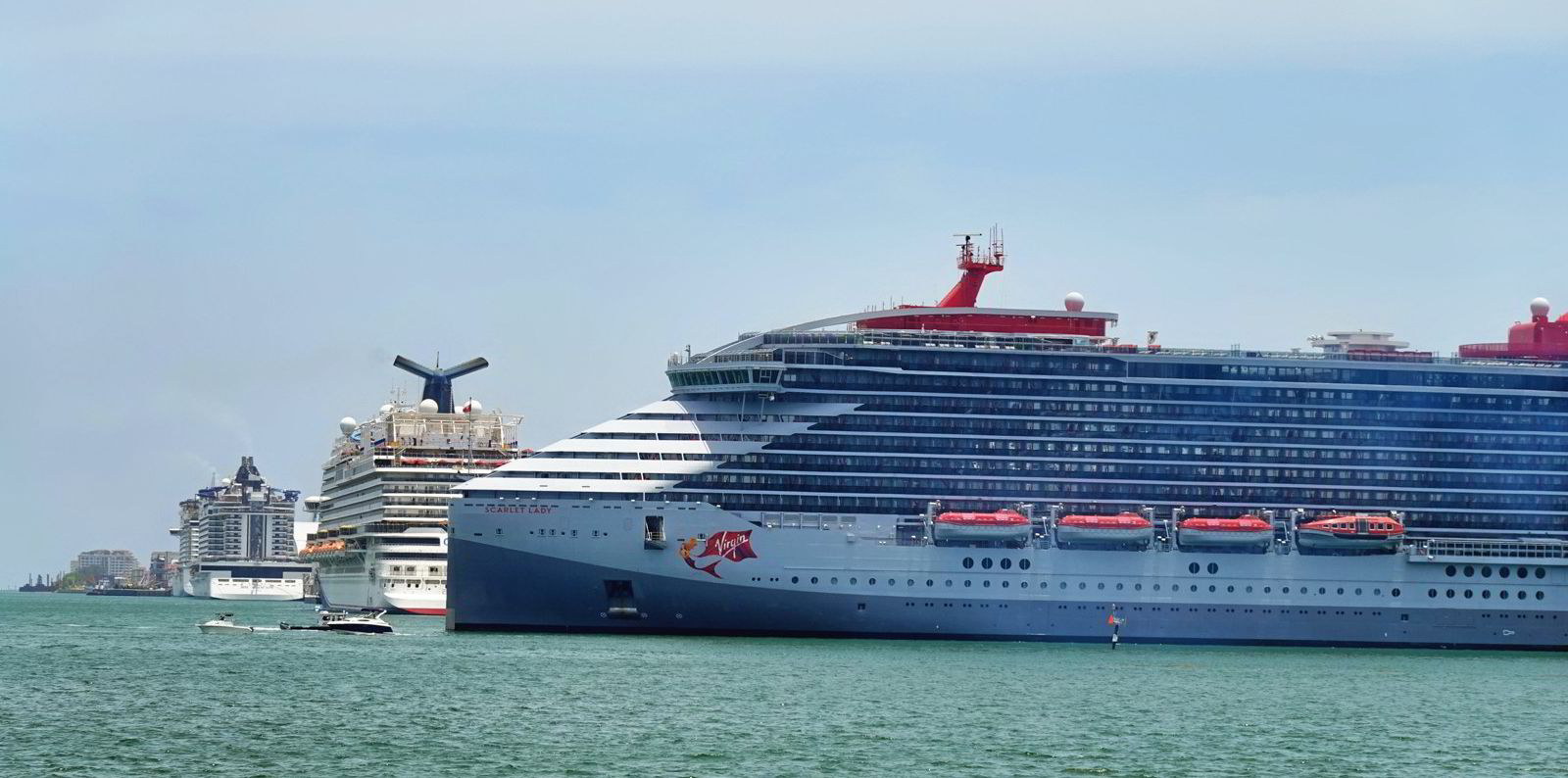The cruise sector does something different from the rest of the shipping industry.
From their onboard roller coasters and entertainment venues to their itineraries including a different destination nearly every day, cruise ships provide vacation experiences rather than simply transportation from one place to another.
And cruise industry leaders believe that one of the two major global regulations that entered force earlier this year does not properly factor in that difference.
So the cruise industry is proposing to alter the equation that underpins the Carbon Intensity Indicator (CII), an International Maritime Organization rule that grades ships depending on their emissions weighed against their “transport work”.
More precisely, cruise wants to change one of the variables in that equation.
A warning: this is about to get nerdy.
For ships that carry cargoes that are not measured in tonnes, such as car carriers and passenger ships, the current CII equation involves dividing the CO2 emissions by the product of the gross tonnage and distance travelled.

The Cruise Lines International Association (CLIA) has proposed that the IMO replace distance with the total time that a ship is operated.

It said the new equation was developed by the Cruise Safety & Sustainability Forum, a coalition of cruise ship operators, shipyards and classification societies.
“The primary concern with the existing metric is that the inclusion of distance travelled in the CII equation renders the metric inappropriate for cruise passenger ships, given the metric’s objective,” the CLIA told the IMO.
‘Complete vacation experience’
“Cruise ships, unlike most other types of ships, do not function purely as a form of transportation. Rather, cruise ships are designed to provide a complete vacation experience to passengers and, as such, devote a significant portion of generated power to hotel services.”
The CLIA said cruise ships also spend 25% to 35% of their time in port, so that passengers can spend time ashore.

It said the current CII rule penalises ships for port time — after all, they are stationary during this time, so there is no distance associated with it.
Yet ships have lower emissions in port than when they are at sea, the group said.
Short distances
“As a result, current CII scores do not highly correlate with absolute carbon emissions, nor do they accurately reflect the efficiency of cruise ships,” the CLIA told the IMO in a document that was filed in April but has yet to be reported in the media.
“Even the most technically efficient cruise ships in the fleet score poorly if operating on itineraries with short distances between port calls and/or high port time.”
Carnival Corp chief maritime officer William Burke told TradeWinds’ Green Seas podcast that the problem for cruise is that the current CII equation means ships can decrease their carbon intensity but still increase their total emissions.

“There’s distance in the denominator, and so if you increase the distance, you’ll reduce your CII,” he said.
“But because you’re going further, you are producing more absolute carbon.”
The CLIA described this as a perverse incentive that encourages ships to reduce port time and increase the distance to achieve a CII score that ultimately results in higher emissions.
Burke, whose company is the world’s largest owner and operator of cruise ships, would like to weigh the carbon intensity of fleets instead of individual vessels.
“If I’ve got a fleet of 10 ships, and they vary in age, and I have to make my oldest ship efficient enough so it doesn’t get sidelined, I am putting money into a ship that’s probably only got a few years left, and taking away money that could go into a ship that has many years left,” he told Green Seas.
He noted that Carnival’s internal carbon intensity calculation simply divides emissions by gross tonnage, with no distance or time.
What could help the carbon intensity of vessels that spend so much time in port is shore power, in which the ship uses the local electricity grid in port to power its hotel load.

Ahead of the recent meeting of the IMO’s Marine Environment Protection Committee, the CLIA joined the International Chamber of Shipping, Interferry and the International Association of Ports & Harbors to propose that a future carbon levy or another economic measure to push the maritime sector towards decarbonisation targets should be spent on shore power.
“The co-sponsors consider OPS [onshore power supply] to be a viable long-term solution for ships at berth, offering significant air pollutants, noise and [greenhouse gas] emission reductions. At the same time, connecting to OPS facilities while at berth offers a way for ships to improve their CII performance,” the groups said.
“However, funding, regulation, lack of detailed and reliable power consumption data and forecasts taking into account further electrification of ships, and standardisation for certain ship types and low-voltage OPS connections, are some of the remaining barriers that need to be addressed.”
_____________
Podcast: Where is shipping’s decarbonisation drive headed after historic IMO decision?
After the IMO decided to target net-zero emissions by “around” 2050, it will now have to turn ambition into regulation that will push shipping towards that goal. Green Seas explores the mechanisms under discussion with Carnival Corp chief maritime officer William Burke and Global Maritime Forum chief executive Johannah Christensen.
_____________
‘A lot of opportunity’: Hornbeck Offshore targets wind farm market with OSV conversion
Hornbeck Offshore Services has signed a deal with Florida’s Eastern Shipbuilding Group to convert one of its US-built vessels to serve the growing offshore wind sector.
And chief executive Todd Hornbeck told TradeWinds that the company has more candidates in its fleet for similar conversions.
The New York-listed company said the shipbuilder will convert the offshore supply vessel (OSV) to work as a service operation vessel, although it will also be able to serve as a floating hotel in the oil and gas market.
_____________
Pattern Energy CEO: Why we’re staying out of the US offshore wind race
While US offshore wind, especially in the north-east, is an important part of the country’s “decarbonisation journey”, Pattern Energy has no plans to invest there in the foreseeable future, chief executive Hunter Armistead told TradeWinds’ sister paper Recharge.
“We have continued to look at whether or not that is something we should be able to step into the fray and take on as part of what we do,” he said. “So far, we have found there is a significant number of very qualified people who seem to be well positioned to deliver on those opportunities.”
Pattern, based in San Francisco, was acquired in March 2020 by Canada Pension Plan Investment Board and later taken private.
Click here to read the story in Recharge.
Read more
- Podcast: Where is shipping’s decarbonisation drive headed after historic IMO decision?
- Jumbo and two directors fined over deals to recycle ships in Turkey
- Editor’s selection: Gatik steps into the shadows, shipping’s price cap headache and Webber’s ESG scorecard previewed
- Streetwise: Michael Webber has his ESG scissors out and they’re going to clip Eagle Bulk’s wings
- ‘A lot of opportunity’: Hornbeck Offshore targets wind farm market with OSV conversion





